Advantages and Disadvantages of Hydroelectric Power PlantWhat is Hydroelectric Power PlantElectricity is produced from hydropower, i.e., water power. Around 16 % of electricity is generated from hydropower, and no other renewable source can produce this much electricity, even not from nuclear power, because hydropower can produce significant quantities of low-carbon electricity on demand, it is essential for developing safe and reliable electricity supply systems. A hydroelectric power plant with a dam and supply qualifies as an adaptable source since the amount of energy provided may be increased or decreased in response to changing power interests. Once built, a hydroelectric complex doesn't generate any direct waste and almost always produces less greenhouse gas than electricity facilities that use fossil fuels. However, significant volumes of greenhouse gases may be released when dams are built in lowland rainforest regions where part of the forest is submerged. 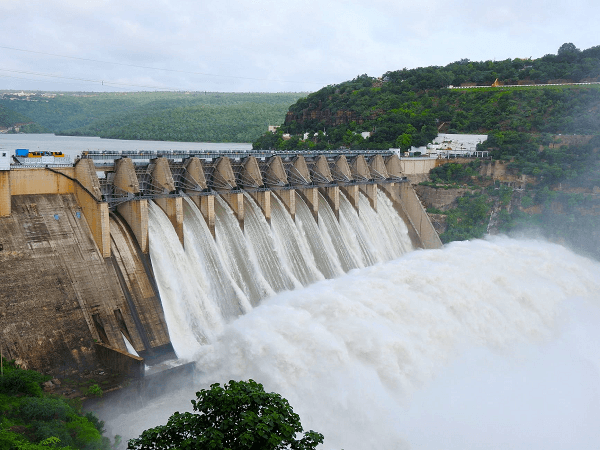
For a very long time, people have used the force of water flowing in rivers and streams to create mechanical energy. One of the first energy sources used to create electricity was hydropower, which, until 2019, accounted for most of all renewable electricity produced annually in the United States. In the United States, utility-scale power generation totaled 6.3% in 2021, and utility-scale renewable electricity generation totaled 31.5%. Over time, hydroelectricity's proportion of total U.S. electricity generation has fallen due to increases in energy production from other sources. To generate hydroelectric power, water is collected or stored at a higher level and transported descending through vast lines or channels (penstocks) to a lower rise; the difference between these two heights is known as the head. The falling water forces turbines to whirl at the end of their journey through the pipes. As a result, the turbines power generators, which turn the mechanical energy of the turbines into power. Transformers convert the generator's substitute voltage to a higher voltage suitable for long-distance transmission. The powerhouse is the structure that houses the turbines and generators and is fed by the lines or penstocks. Generating Method1. Conventional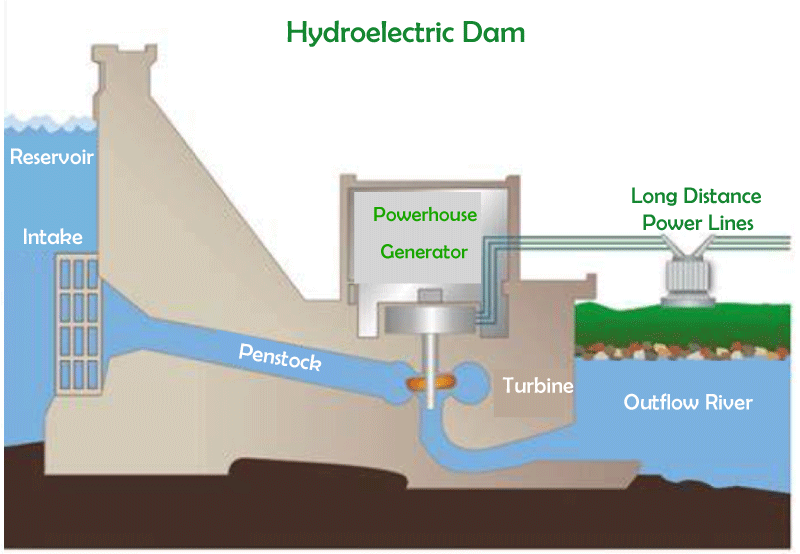
The conventional majority of hydroelectric electricity is generated by the potential energy of dammed water driving a water turbine and generator. Water is delivered from the supply to the turbine via a massive conductor known as the "penstock." the amount of electricity extracted from the is determined by the volume and level disparity between the source and the water's outpouring. 2. Pumped-Storage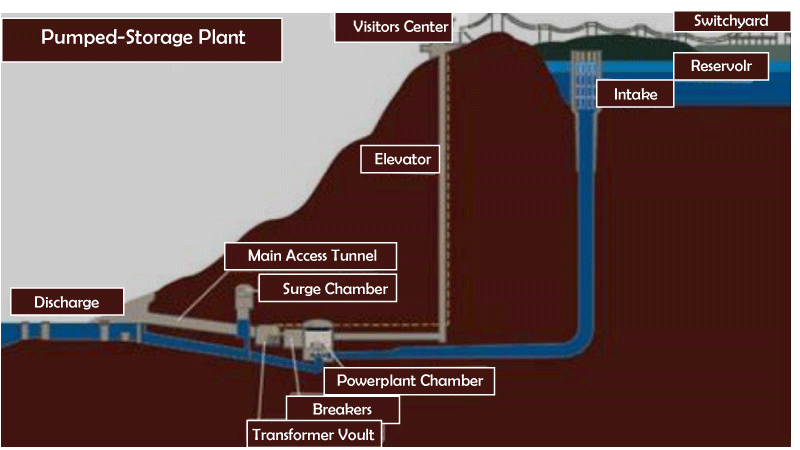
This approach generates power to meet peak demand by transporting water between reservoirs at various elevations. When there is a low power interest, the excess age limit is employed to siphon water into the higher repository, resulting in an interest-side reaction. When the demand increases, a turbine drives water back into the lesser supply. Siphoned capacity frameworks will provide about 85% of the world's 190 GW of lattice energy capacity by 2021, increasing the age framework's daily limit factor. Siphoned capacity is not an energy source and appears as a negative value in posts. 3. Run-of-the-River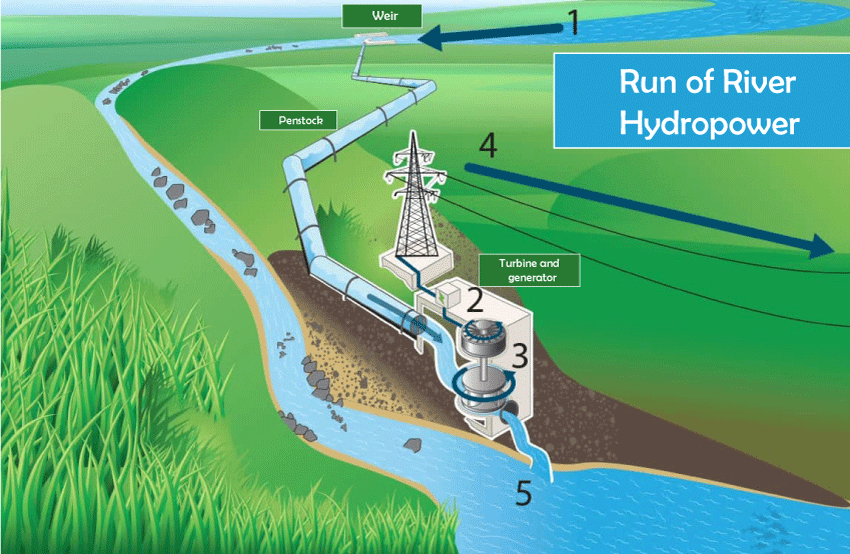
Run-of-the-river hydroelectric facilities have minimal or no reservoir capacity; thus, only water from upstream is available for generating at the time, and any excess must pass unused. A consistent supply of water from a lake or existing reservoir upstream is a key advantage for selecting run-of-the-river sites. 4. Tide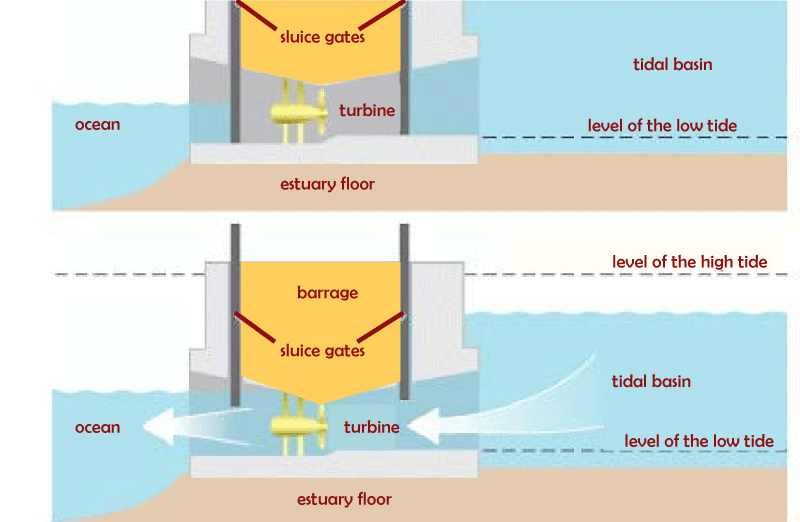
Tidal power is only feasible in a few spots across the world. When there is a low power interest, the excess age limit is employed to syphon water into the greater supply, resulting in an interest side reaction. When the request is increased, a turbine drives water into the lower repository once again. Siphoned capacity frameworks will provide about 85% of the world's 190 GW of network energy capacity by 2021, increasing the age framework's daily limit factor. Siphoned capacity is not an energy source and appears as a negative value in posts. The Largest Hydropower Plants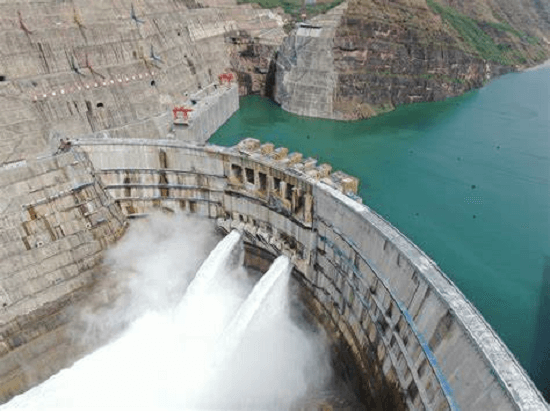
China, Brazil, Canada, the United States, and Russia are the top five hydropower producers. Three Crevasses (Sanxia) on China's Yangtze Waterway is the world's largest hydroelectric office in terms of installed capacity, measuring 1.4 miles (2.3 kilometres) broad and 607 feet (185 metres) high. The Itaipu plant, located on the Paraná Waterway between Brazil and Paraguay, generates the most power every year. The largest hydroelectric plant in the United States is located at the Stupendous Coulee Dam on the Columbia Stream in Washington, which relies on hydropower for around 66% of its electricity. Advantages of Hydroelectric Power Plant1. Flexibility Hydropower is a versatile energy source because stations may be moved quickly to meet changing energy demands. For a few seconds, hydro turbines start a season of the request. Even though battery electricity is faster, its capacity is negligible compared to hydro. Most hydro units can be brought up to full load in about 10 minutes, faster than atomic and virtually all petroleum derivative power. Power age can also be swiftly reduced when there is an excess of force age. As a result, except for draining the flood pool or addressing downstream demands, the limited capacity of hydropower units is rarely used to generate base electricity. 2. Cheapest Energy Source Even though the initial investment required to build a plant is incredibly substantial and somewhat of a challenge, water power is unquestionably the least expensive source in the medium to long run. When the dams and stations are built and the turbines are installed, they require less support than the initial investment. While digitization necessitates more investment, the expense of innovating is mitigated by improvements in efficacy and other advantages such as waste reduction. 3. Reduced CO2 Emission Hydroelectric dams with low CO2 discharge do not need fuel, and power generation does not emit carbon dioxide. While carbon dioxide is emitted during the project construction and some methane is released annually by archives, hydro has one of the lowest lifetime ozone-draining material outflows for the power age. The low ozone-depleting substance effect of hydroelectricity is being studied, particularly in quiet surroundings. Tropical places have more ozone-depleting substance emanation effects because the supplies of force stations in tropical areas release more methane than those in mild areas. Like other non-petroleum-derived sources, hydropower produces no sulfur dioxide, nitrogen oxides, or other particles. 4. Water Brings With it Huge Energy Hydropower has enormous energy capacity. The large amounts of water found at such heights contain a lot of gravitational potential energy, and even a little portion of it will provide much power. At the very least, all of the world's largest power plants are hydroelectric, and only one station can provide the energy needs of millions of people. 5. High-Value Power The primary advantage of typical hydroelectric dams with provisions is their ability to store water for a low cost for later dispatch as high-value clean electricity. In 2021, the International Energy Agency (IEA) estimated that "vaults of all flow conventional hydropower plants combined can store a total of 1 500 terawatt-hours (TWh) of electrical energy in one full cycle," which was "on various occasions more energy than the overall naval force of siphoned storing hydropower plants". During the 2020s, the battery capacity limit is not expected to exceed siphoned capacity. When used as peak capability to meet demand, hydroelectricity is more valuable than baseload power and far more valuable than intermittent energy sources like wind and sunlight. Hydroelectric power facilities have long monetary lifetimes, with some units continuing operation after 50-100 years. Work costs are also often minimal because factories are automated and have few professors on site during normal operation. A hydroelectric station with reasonably low development costs might be constructed where a dam meets many purposes, providing a beneficial revenue stream to offset dam activity expenses. It has been established that the electricity provided by the Three Crevasses Dam will cover the development expenditures after 5 to 8 years of full age. 6. Hydropower Stations Help the Environment The emphasis on hydropower is frequently on the stations' effect on the environment; however, hydropower can also benefit the climate. For example, having more water available in repositories means more spectacular flora, attracting more species and raising the surrounding area's population. Furthermore, hydropower stations trap trees and branches, keeping streams clean and, as a result, more navigable. 7. Hydropower is Becoming More Affordable to Individual Customers Scaled-down hydro plants, which are small and meant for domestic or hyperlocal consumption, gained popularity at the start of this long time. While developing plants that pre-owned water power for homegrown things was previously restricted, this is now an unquestionably appealing opportunity, allowing customers to make enough power to satisfy their energy demands while also taking care of the excess power created into the lattice. Disadvantages of Hydroelectric Power Plant1. Impact on the Environment When discussing hydropower plants, we cannot ignore the biological outcomes that are inextricably linked to human impact on nature. Each hydropower plant, in particular, proposes distinct natural modifications, whether an altered conduit or the growth of transmission lines and roadways. There is also a fascinating link between human and organic components, which affects natural life in rivers, lakes, and seas. When discussing biological standards, it should be emphasized that ecosystems, particularly water, are impacted by factors such as water level, stream speed, or entrance to food, as well as the possibility of a haven for fish that reside there. Fish regions have also been created based on some of these borders. Everything we do to modify the fish biological system may be alarming to certain fish species. 2. Hydroelectric Power Plant Displaces Human Natural Environment This success simplifies many things for us but also impacts our fulfillment. Living areas must be relocated from time to time due to the growth of hydropower plants, and we don't just mean animal habitats but also human communities. It is very normal for people to need to relocate due to such changes, even if they have lived in the same place their whole life. Even though their migration has been resolved, there remains one issue that cannot be resolved: their way of life. Many people believe that by relocating, they have suffered a great loss that nothing can compensate for. Furthermore, some metropolitan areas and towns have undoubtedly been almost taken off the earth along these lines. They remained only as a spot on the hydrological map. 3. Construction Conditions are Limited While this is a cost-effective method of producing energy, it does not imply that there are no constraints. We should recall the construction of dams - since it is often regarded as a typical limiting factor. The dike, in particular, cannot be worked on in any location. As a result, it is critical to ensure that the location where the hydropower plant is being built can support this - while also being financially and environmentally sustainable. Most relevant locations are currently heavily used for this purpose. 4. Dam Construction is Expensive This is one of the most significant disadvantages of constructing a hydropower facility. The dam's construction is the most expensive development since it is a significant investment. In any event, this does not imply that the construction of each dam is a very expensive undertaking. Some of them can be completed in two to five years, while others require more development time. As a result, the costs rise. Exorbitant development cutoff periods, without a doubt, raise expenses; thus, greater thought should be given to these issues later. 5. Siltation and a Lack of Flow When water flows, it can carry particles heavier than itself downstream. This hurts dams and power plants, particularly those located on rivers or within catchment areas with considerable siltation. Siltation can fill a repository, reducing its ability to manage floods and putting an extra flat load on the dam's upstream section. Finally, a few supplies may be filled with residue and useless or up and over during a flood and fizzle. 6. Methane Leaks (From Repositories) It has been discovered that the supply of Power plants creates considerable amounts of methane in marsh rainforest locations where immersion of a piece of wood is crucial. This is due to plant debris decomposing in overburdened areas in an anaerobic climate and producing methane, an ozone-damaging chemical. 7. Failure Risk Because massive regular dammed-hydro offices hold tremendous quantities of water down, a disappointment due to poor development, cataclysmic catastrophes, or destruction may be disastrous to downriver towns and foundations. During Hurricane Nina in 1975, the Banqiao Dam in Southern China burst after a year's worth of rain poured in less than 24 hours (see 1975 Banqiao Dam disappointment). The ensuing flood killed 26,000 people, while scourges killed an additional 145,000. Millions of people were left impoverished. The construction of a dam in an unsuitable geological position may result in tragedies such as the 1963 accident at the Vajont Dam in Italy, which killed over 2,000 people. |
 For Videos Join Our Youtube Channel: Join Now
For Videos Join Our Youtube Channel: Join Now
Feedback
- Send your Feedback to [email protected]
Help Others, Please Share










